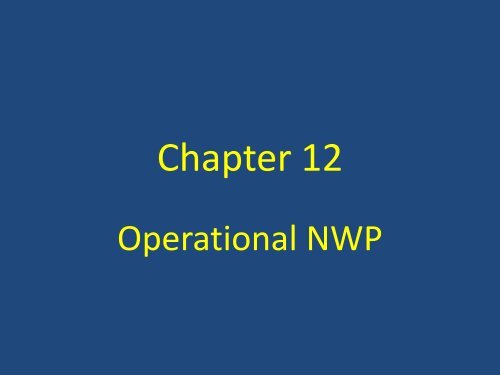Chapter 12 - Operational NWP.pdf
Chapter 12 - Operational NWP.pdf
Chapter 12 - Operational NWP.pdf
Create successful ePaper yourself
Turn your PDF publications into a flip-book with our unique Google optimized e-Paper software.
<strong>Chapter</strong> <strong>12</strong><br />
<strong>Operational</strong> <strong>NWP</strong>
<strong>Operational</strong> models are run by:<br />
• Large weather services – e.g., NCEP, ECMWF,<br />
UKMO, DWD…<br />
• Universities – for educational purposes<br />
• Insurance companies<br />
• Consulting companies<br />
– general high-res weather providers<br />
– Specialized products: air-quality, aviation, road weather,<br />
agriculture, maritime<br />
• Small countries<br />
• Defense-related organizations – Navy, Army, Air<br />
Force
A simple operational modeling system<br />
Specialized<br />
secondary models
<strong>Operational</strong> weather vs<br />
operational climate prediction<br />
• There is no well-defined forecast-length<br />
threshold that distinguishes the two terms<br />
– e.g., interseasonal prediction: is it<br />
weather or climate?<br />
• Decadal climate predictions will soon be<br />
initialized like weather forecasts, so there is<br />
no distinction in that sense.
Model reliability – a distinction<br />
between research and operational apps<br />
• Research apps – if the model crashes,<br />
you just fix the problem and rerun<br />
• <strong>Operational</strong> apps – a crash in a<br />
sequential initialization process is<br />
difficult to gracefully recover from,<br />
and may require a cold start.
Causes for model crashes<br />
and how to avoid them<br />
• Computer hardware problems – hard to<br />
anticipate.<br />
• CFL errors – Using a very short Δt to guarantee<br />
that no violations will ever occur wastes<br />
computer time (that could be used for higher<br />
resol). But the Δt for an operational model<br />
should be somewhat smaller than for a<br />
research model.
• Transmission of observations may be<br />
interrupted – but, we can initialize from the<br />
background only, if needed.<br />
• LBCs for LAMs – If the global model does not<br />
complete on time, or at all, the cycle for the<br />
LAM is compromised.<br />
• Severe LBC noise with LAMs can cause a crash.<br />
• Physical-process parameterizations may not<br />
work for an unusual combination of inputs.
Other considerations related to LAMs<br />
• The initialization is delayed for a few hours<br />
because it is necessary to wait for the global<br />
model to finish its forecast (LBCs).
Factors that control<br />
model execution speed<br />
• Must wait for most observations to arrive – model “cutoff”<br />
times can be 60-90 minutes.<br />
• For LAMs, must wait for the LBCs<br />
• The time step – requirement depends on numerical<br />
approach, and how conservatively the time step is chosen if<br />
there is a constraint.<br />
• The number of grid points<br />
• The speed of the processors, the number of processors,<br />
and how well the execution time scales with the number of<br />
processors.<br />
• The sophistications of the physics parameterizations<br />
• Make output available as the model is running.<br />
• Execution speed versus user friendliness<br />
• Large I/O loads can slow execution speed.
Types of post-processing<br />
of the met forecasts<br />
• Bias correction (Chap 13)<br />
• Statistical diagnosis of variables that are<br />
not forecast well – fog, freezing rain,<br />
turbulence intensity<br />
• Secondary models (Chap 14)
Miscellaneous topics<br />
• Managing model development – requires<br />
multiple computer systems<br />
– Primary forecast system<br />
– System for parallel runs to test upgrades<br />
– R&D system<br />
• Real-time verification<br />
• The relative roles of models and forecasters
Properties of user-friendly<br />
operational displays














